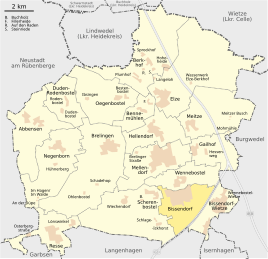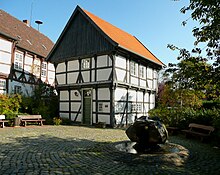Bissendorf (Wedemark)
|
Bissendorf
Wedemark municipality
|
|
|---|---|
| Coordinates: 52 ° 31 ′ 29 ″ N , 9 ° 45 ′ 27 ″ E | |
| Height : | 55 (48-92) m above sea level NHN |
| Area : | 11.29 km² |
| Residents : | 5033 (December 31, 2015) |
| Population density : | 446 inhabitants / km² |
| Incorporation : | March 1, 1974 |
| Postal code : | 30900 |
| Area code : | 05130 |
|
Location of Bissendorf in Wedemark
|
|
|
Official house with registry office in Bissendorf
|
|
Bissendorf is the second largest district of the municipality Wedemark in the Hanover region in Lower Saxony .
history
The first documentary mention was made in 1295 in connection with the St. Michaelis Church, which stands opposite the Amtshof, to which the undershot water mill in Krakow, which was demolished in 1773, also belonged. Bissendorf was the seat of the respective magistrate from 1560 to 1852 .
Bissendorf was a farming village for centuries. The original 13 Meierhöfe were mostly divided over the years, so that, for example, in 1664 a total of 33 farms had Meier status. In addition, there were almost 40 other (smaller) Kötnerhöfe at that time . The economic basis was the cultivation of grain, primarily rye , and cattle breeding, especially horses, cattle and sheep. Between 1850 and 1930 the population increased from around 600 to around 1000 people.
On March 1, 1974, Bissendorf was incorporated into the new municipality of Wedemark.
politics
Local council
The local council of Bissendorf consists of five councilors and four councilors from the following parties:
(Status: local election September 11, 2016)
Local mayor
The local mayor is Susanne Brakelmann (CDU), she is represented by Gitta Jansen (SPD).
coat of arms
The design of the coat of arms of Bissendorf comes from the heraldist and graphic artist Alfred Brecht , who was born in Gadenstedt and later lived in Hanover , and who also designed the coat of arms of Bantorf , Barrigsen , Egestorf and many other localities in the Hanover district. The approval of the coat of arms was granted on November 17, 1955 by the Lower Saxony Minister of the Interior .
| Blazon : "In green a silver pillar head of the office door of 1691 with the cipher GW ." | |
| Justification of the coat of arms: In keeping with the character of the landscape, Bissendorf chose the green coat of arms as the center of Wedemark. Prehistoric symbols were not offered. Until 1852, Bissendorf was the former seat of the magistrate and the court for Wedemark. In memory of this, the headpiece with the broken-off upper part of the right column of the entrance portal to the old courtyard was included in the coat of arms. The column bears the intertwined initials "GW" of Duke Wilhelm von Braunschweig - Lüneburg . |
Culture and sights
- When the district bailiff was founded around 1560, the home of the bailiff was built, today the registry office, one of the most beautiful secular buildings in Wedemark, to which a west wing was added in 1611. Close by is the so-called Kavaliershaus, which was built around 1620/1621 and today houses the Richard Brandt Museum . Both buildings show the ornamentation of the late Renaissance.
- The official building of the office, the Amtsvogtei, was built in 1819 and was last used as a department store by the Busse family before it was acquired by the municipality of Wedemark and extensively converted into a community center and restored in 2007.
- The former guest house and farmhouse, a half-timbered building from 1809, is located to the south and houses the community library and another exhibition room of the Richard Brandt Museum on the top floor.
- Opposite the Amtshaus is the Michaeliskirche, the tower of which was built in the 13th century and renovated in 1680.
- The historic tombstones on the church are worth seeing. The mill belonging to the church, an undershot water mill located outside the village , was demolished around 1773.
- West of Bissendorf half way to Resse located Bissendorfer Moor with the in in Langenhagen located Muswillensee .
Architectural monuments
Association
The imago-Kunstverein Wedemark e. V., an association for visual arts, music, literature and performing arts.
In Bissendorf there is a football club (SC Wedemark), a gymnastics club (with the Bissendorfer Panthers who are successful in inline hockey ), a tennis club, the chess club "Wedemärker Freibauer", the volunteer fire brigade, the social association and the local CDU and SPD associations. Above all, the "Beautification and Nature Conservation Association" VNV-Bissendorf is worth mentioning, which looks after the village as well as looking after nature and preserving the old half-timbered houses.
The Schützengesellschaft Bissendorf from 1912 e. V. holds the Bissendorfer Schützenfest every year at Whitsun . Until around 1940, the historic shooting association administered and celebrated three festivals a year. The cooperative included the landlords (farm owners) from the Realgemeinde Bissendorf, Scherenbostel, Ickhorst and Wiechendorf. A former “Schützenbier” was served for the children under the guidance of the teachers, another for the servants and maids and another for the farmers and married workers. To this end, the cooperative appointed a member to organize the festival on his farm. He got the liquor license. It was not until 1935 that the rifle festival became a “people's and rifle festival” through a municipal resolution.
Economy and Infrastructure
In Bissendorf there is a wide range of shops, medical practices, workshops, pharmacies and banks. There is a primary school with branch offices.
traffic
There are bus connections to other parts of Wedemark, as well as to the cities of Langenhagen and Burgwedel. The Bissendorfer Bahnhof is connected to other villages in Wedemark, Hildesheim and Hanover via the Hanover S-Bahn network.
Personalities
- Heinrich Henstorf (1859–1953), founder of the Henstorf Foundation
- Hinrich Braasch (1878–1968), Low German author, lived and worked in Bissendorf from 1904
- Peter Greve (1910–1983), sculptor and painter, lived and worked in Bissendorf
- Hellmuth Hahn (1927–2015), local researcher, historian, doctor and local politician
- Klaus Meine (* 1948), singer of the Scorpions , songwriter
- Matthias Jabs (* 1955), guitarist for the Scorpions
- Heinz Rudolf Kunze (* 1956), writer, rock singer, musical writer / translator, lecturer
- Harald Welzer (* 1958), sociologist and social psychologist
- Frank Hanebuth (* 1964), Hells Angels leader in Hanover
- Tjark Bartels (* 1969), former mayor of the municipality of Wedemark
- Helge Zychlinski (* 1979), acting mayor of the municipality of Wedemark
literature
- Heinrich Henstorf: Chronicle of Bissendorf , Hanover: Verlag Hannoverscher Anzeiger Madsack & Co., 1939
- 2nd edition, plus a foreword from 1985, digital new edition, ed. by Christa and Friedrich Lüddecke, Neustadt / Evensen, 2004; Digitized as a Word document on the wedemark-chroniken.de website
- Carolin Krumm (arr.) Et al. , Peter Ferdinand Lufen, Dietmar Vonend (Red.): Wedemark / Bissendorf. In: Monument topography Federal Republic of Germany , architectural monuments in Lower Saxony , Hanover region, northern and eastern part with the cities of Burgdorf, Garbsen, Langenhagen, Lehrte, Neustadt a. Rbge., Sehnde, Wunstorf and the communities of Burgwedel, Isernhagen, Uetze and Wedemark (= publications of the Lower Saxony State Office for Monument Preservation , Volume 13.2), ed. by Christiane Segers-Glocke , CW Niemeyer, Hameln 2005, ISBN 3-8271-8255-7 , pp. 130 f., 482–491; and Bissendorf, Gem. Wedemark , o. a. Cit., P. 574 f.
Web links
Individual evidence
- ↑ Area information for the municipality of Wedemark. (PDF; 10 kB) In: Website of the municipality of Wedemark. January 1, 2011, accessed May 6, 2019 .
- ↑ Area information including Bissendorf-Wietze and Wennebostel-Wietze.
- ↑ Population of the community Wedemark. (PDF; 121 kB; p. 2) In: Website of the municipality of Wedemark. December 31, 2015, accessed May 6, 2019 .
- ^ Federal Statistical Office (ed.): Historical municipality directory for the Federal Republic of Germany. Name, border and key number changes for municipalities, counties and administrative districts from May 27, 1970 to December 31, 1982 . W. Kohlhammer GmbH, Stuttgart / Mainz 1983, ISBN 3-17-003263-1 , p. 221 .
- ↑ a b local council of Bissendorf. On: Website of the municipality of Wedemark - Ortschaft Bissendorf, accessed on July 20, 2017.
- ^ A b Landkreis Hannover (ed.): Wappenbuch Landkreis Hannover . Self-published, Hanover 1985, p. 480-481 .
- ^ Stephan Hartung: Volkmar Biesalski adopted (Henstorf Foundation). In: Hannoversche Allgemeine Zeitung , dated February 26, 2015, updated March 1, 2015, accessed on August 15, 2017.









